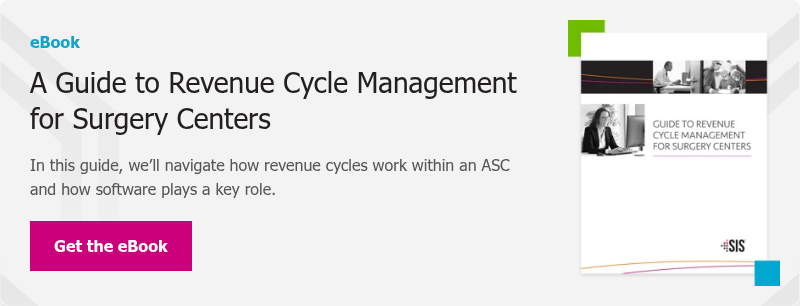In a previous article, “What is Revenue Cycle Management?”, we walked you through the steps of an ambulatory surgery center's (ASC's) successful revenue cycle management (RCM) process. While it is helpful to understand all that a comprehensive RCM process entails, I also thought it would be worthwhile to discuss tools that your ASC can use to streamline this critical process.
In this article, I discuss RCM software solutions that can help improve the efficiency of each element of your RCM process, from when patients book their appointment through when your ASC assesses its revenue cycle performance.
Patient Management
Patient management in RCM includes all the processes necessary to bring a patient into the ASC for surgery, including scheduling, registration, and insurance verification. Most ASCs use a business management solution to handle aspects of patient management, but a few specific solutions can help make this process even easier. For example, these include:
- Online patient portal: Collecting pre-admission data helps ensure a successful procedure and high level of patient satisfaction at your ASC. However, gathering this information is not always easy as it often requires extensive paperwork and lengthy pre-admission phone calls. By integrating your business management solution with an online patient portal, patients can enter their own information at their convenience prior to the day of surgery, helping increase pre-admission efficiency and information accuracy.
- Electronic insurance verification: Failure to verify the accuracy of patient insurance information at the time of scheduling and collect funds due at the time of service can result in significant receivables work on the back end. With electronic insurance verification, your scheduler can request insurance eligibility information at the time of scheduling to more easily track and collect patient responsibility amounts, reducing accounts receivable (A/R) and increasing cash flow.
- Text Communication: There are really great HIPAA compliant text messaging applications that help improve communication with patients. With these applications, you can send appointment reminders and pre-op instructions to improve your intake process and you can also send notifications for past-due balances to help with collections. If your ASC uses an online payment portal, you can even send links to the patient to submit their payment.
Claim Preparation and Submission
Following a procedure, a good RCM process will allow an ASC to quickly and accurately file and submit a claim to the patient’s insurance company. If you are manually filling out and submitting claims, you are increasing the likelihood of an error and will not to get your claim out the door as quickly. Some RCM software solutions to help automate this process include:
- Clinical documentation solution: In healthcare, the adage goes “if it wasn’t documented, it didn’t happen.” All insurance claims are based on the information charted in the patient’s medical record during the procedure. A clinical documentation solution integrated with your business management solution can help increase the amount and accuracy of procedure data captured during the procedure and automatically import that information into the claim. Information such as billable supplies, diagnosis and procedure codes, and procedure notes can be easily captured and transferred to the business management system for claim preparation.
- Claim scrubbing: Many modern ASC business management solutions may come with claim scrubbing functionality. With this solution, your system will check for missing or incorrect information prior to sending the claim to the insurance company. For instance, claim scrubbing will review your codes for “reason for visit,” “external cause of injury,” “primary diagnosis code,” “other diagnosis code,” and “ICD procedure code,” and provide a warning or reject the claim if the incorrect information is reported on the file.
Claim Management
Once the claim is submitted, claim management helps ensure that your ASC receives payment. Effective claim management helps your center deal with issues like lost claims, requests for additional documentation, and denials. Some software solutions that assist with this process include:
- Denial and appeal management solutions: One way to keep an eye on the status of claims is with a denial and appeal management solution that integrates with your business management solution. Such a solution can make it easy for your team to edit claims and resubmit them. It can also provide payer-specific paperwork and accurately populate information into the paperwork.
- Electronic remittance posting (ERP): Lost claim remittances and time-consuming manual payment posting processes can lead to costly delays and unrealized revenue. Using ERP allows your team to automatically post electronic remittance advice (ERA) for primary, secondary, and tertiary payments and write-offs. It also provides control over what is posted and rejected from the ERA, saving time and reducing manual processes and errors.
A/R Management
A/R management helps to ensure payments are captured in a timely manner. Effective A/R management allows the ASC to monitor the status of unpaid or partially paid claims and bills and identify appropriate actions to capture those payments. Some tools that can help monitor and collect payments include:
- Business intelligence/analytics: Business intelligence solutions are a great way to gain a full picture of where your revenue cycle is thriving and where it is falling short. Examples of A/R metrics worth measuring include A/R aging, date of service to posting date, and A/R burn down. Analytics also allow you to drill down into these metrics to find out the root cause of any A/R performance issues. For instance, you can filter your A/R metrics by payer, specialty, and date as well as compare past and current performance. This allows you to focus efforts to improve your processes.
- Automatic account turnover to collections: Despite your best efforts, you may need to write-off some accounts as bad debt or turn them over to a collection agency. Some business management solutions have functionality to electronically turn accounts over to a collections company and display an “in collections” status in the patient record. This feature can also notify staff of the collections status so they avoid scheduling cases for patients with accounts still in collection.
Follow-up
Effective claim follow-up requires consistent communication with insurance companies to ensure that your ASC's claims are processed in a timely manner. The more consistent you are with follow-up, the quicker you can identify the status of your claims and learn of potential denials, enabling a faster response and resolution. An example of a solution that can help with follow-up is:
- Workflow Tool: A good business management solution should have an RCM module that allows you to identify accounts due for follow up either by last bill date or worked date, assign status of where the account stands in the follow up process, and assign reminder dates or tasks that will provide notifications when follow-up dates are near or past due.
Reporting
Understanding your data and the stories it tells — good and bad — is essential for identifying areas to target for improvement. An effective way to analyze your ASC's data is by generating detailed reports on your revenue cycle performance and then drilling down to identify where performance is below the standard you set for your facility. Tools to help with reporting include:
- Business intelligence/analytics: As noted earlier, business intelligence solutions are designed to provide a deep dive into your operations and help you learn the full story of your revenue cycle performance. These solutions generate reports that can be discussed, assessed, and then acted upon. Following implementation of improvement measures, generating updated reports can help determine whether the measures are having their desired effects.
- Practice management solution: Practice management solutions often include reporting functionality. While this functionality may not drill down as deep as a business intelligence solution, the surface-level reports generated can still help to identify some areas of operations performing below expectations.




























